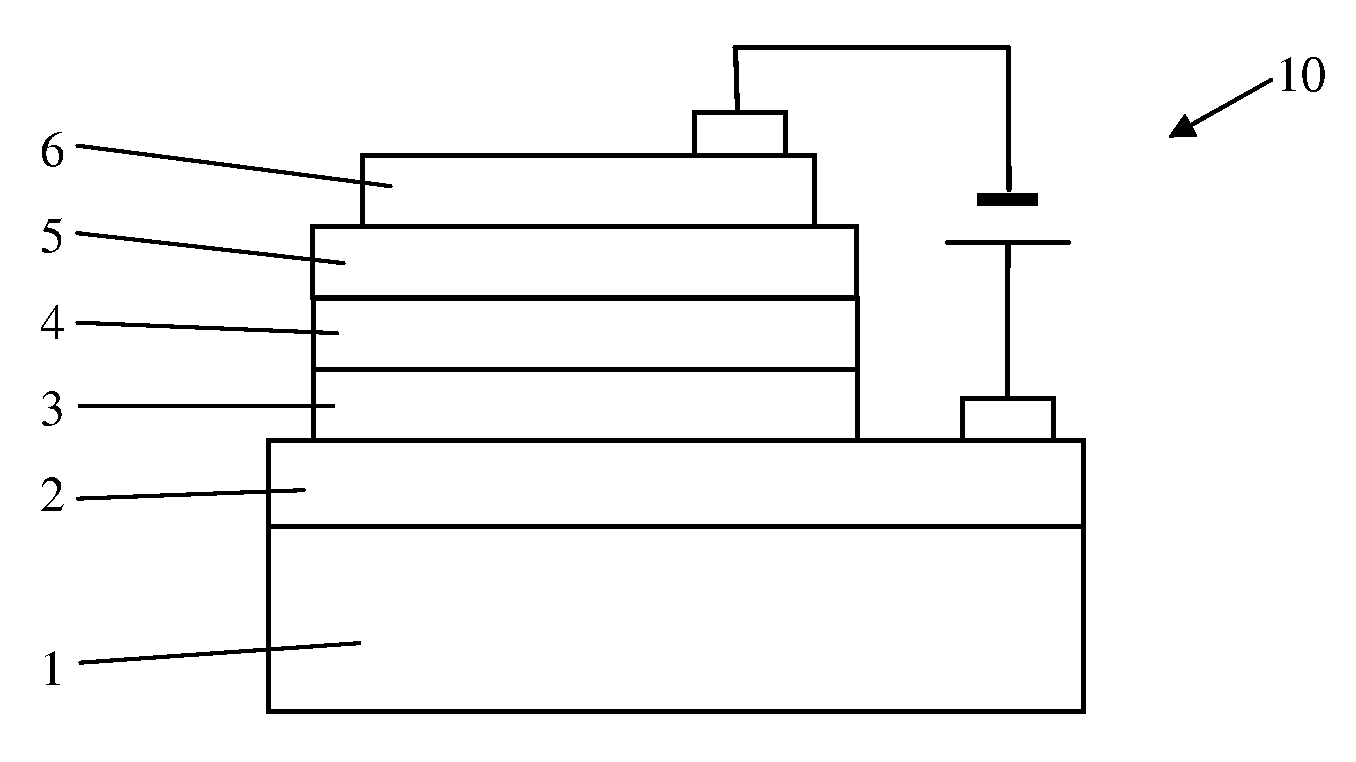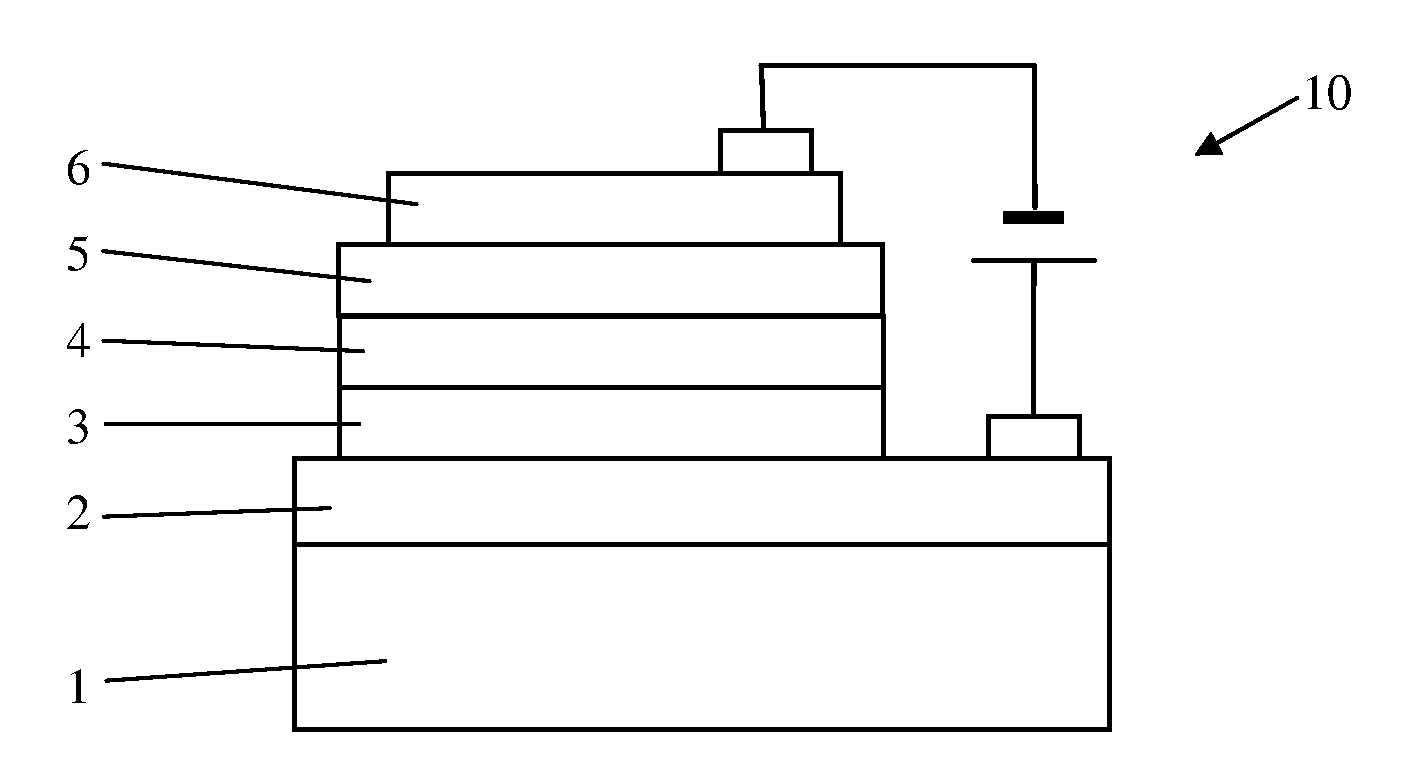Organic electroluminescence device
a technology of electroluminescence and organic materials, applied in the direction of luminescnet screens of discharge tubes, organic chemistry, natural mineral layered products, etc., can solve the problems of low luminance, inconvenient dopants, and prevented efficient injection and transport of charge carriers into the light-emitting layer, etc., to achieve narrow emission band, significant efficiency drop, and high efficiency
- Summary
- Abstract
- Description
- Claims
- Application Information
AI Technical Summary
Benefits of technology
Problems solved by technology
Method used
Image
Examples
example 1
Synthesis of Neutral Red Derivative Compound 1
[0030]0.25 g Neutral red and 0.2 g 4-chloro-1,8-naphthalic anhydride were suspended in 20 ml quinoline. The mixture was refluxed for 24 hrs. at 220° C. under nitrogen. After cooling, the solution was poured into 50 ml ethanol. A red precipitate was collected, purified by recrystalization from ethanol; after dryness, 0.32 g deep red needles were obtained. 1HNMR (300 MHz, CDCl3) δ [ppm]: 2.43 (s, 3H), 3.23 (s, 6H), 7.07 (d, J=3.0 Hz, 1H), 7.62-7.65 (m, 1H), 7.83-7.88 (m, 2H), 8.01-8.15 (m, 2H), 8.33-8.36 (m, 2H), 8.71-8.74 (m, 2H); Anal. Calcd. For C27H19 Cl N4O2: C, 69.45; H, 4.10; N, 12.00%. Found: C, 69.63; H, 4.35; N, 12.19%; MS: m / z 467 (M++1).
[0031]Table 1 lists the absorption and emission maxima and fluorescence quantum yields of compound 1 in a variety of solvents. A red shift in the absorption and emission maxima was observed with increasing solvent polarity. The fluorescence quantum yield of compound 1 reveals a significant depen...
example 2
Synthesis of Neutral Red Derivative Compound 2
[0032]0.35 g Neutral red and 0.1 g 1,2,4,5-benzenetetracarboxylic anhydride were suspended in 20 ml quinoline. The mixture was refluxed for 48 hrs. at 220° C. under nitrogen. After cooling, the solution was poured into 50 ml ethanol. A red precipitate was collected, purified by re-crystallization from ethanol; after dryness, 0.18 g deep red solid were obtained. Anal. Calcd. For C40H30N8O4: C, 69.96; H, 4.40; N, 16.32%. Found: C, 69.86; H, 4.56; N, 16.59%; MS: m / z 687 (M++1).
example 3
Synthesis of Neutral Red Derivative Compound 3
[0033]0.25 g Neutral red and 0.1 g Naphthalene-1,4,5,8-tetracarbolxylic dianhydride were suspended in 20 ml quinoline. The mixture was refluxed for 48 hrs. at 220° C. under nitrogen. After cooling, the solution was poured into 50 ml ethanol. A red precipitate was collected, purified by recrystalization from ethanol; after dryness, 0.22 g black red solid were obtained. Anal. Calcd. For C44H32N8O4: C, 71.73; H, 4.38; N, 15.21%. Found: C, 71.83; H, 4.65; N, 15.59%; MS: m / z 737 (M++1).
[0034]Electroluminescence Device Fabrication
[0035]The detailed results of electroluminescence (EL) are indicated in the following specific examples of the present invention. It is evident that the EL devices shows very bright orange to red emission with high efficiencies and relatively narrow emission band, and the current efficiencies of EL devices remain almost unchanged in a wide range of drive current density up to 500 mA at different doping concentrations,...
PUM
| Property | Measurement | Unit |
|---|---|---|
| current density | aaaaa | aaaaa |
| brightness | aaaaa | aaaaa |
| current efficiency | aaaaa | aaaaa |
Abstract
Description
Claims
Application Information
 Login to View More
Login to View More - R&D
- Intellectual Property
- Life Sciences
- Materials
- Tech Scout
- Unparalleled Data Quality
- Higher Quality Content
- 60% Fewer Hallucinations
Browse by: Latest US Patents, China's latest patents, Technical Efficacy Thesaurus, Application Domain, Technology Topic, Popular Technical Reports.
© 2025 PatSnap. All rights reserved.Legal|Privacy policy|Modern Slavery Act Transparency Statement|Sitemap|About US| Contact US: help@patsnap.com



